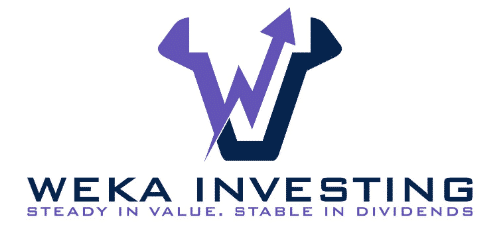Revolutionize Your Portfolio: Dividend Investing with the Core-Satellite Approach
Are you ready to take your investment portfolio to new heights? If so, we have an innovative approach that combines the power of dividend investing with the core-satellite strategy.
By revolutionizing your portfolio with this dynamic combination, you can generate consistent income while still allowing for growth. In this article, we will delve into the world of dividend investing meets the core-satellite approach and explore the synergies between these two strategies.
Dividends are a key component of many successful investment portfolios. They represent a distribution of a company’s earnings to its shareholders, providing them with a regular stream of income. This income can be reinvested or used as cash flow, offering investors flexibility in how they choose to utilize it. With dividends, you can enjoy both short-term benefits and long-term growth potential.
Now let’s talk about the core-satellite approach. This strategy involves building a diversified portfolio by combining passive index funds (the ‘core’) with actively managed satellite investments. The core provides stability and broad market exposure, while the satellites offer potential for outperformance through active management.
By implementing this approach alongside dividend investing, you can create a well-rounded portfolio that balances income generation and growth opportunities.
By combining dividend investing with the core-satellite approach, you can tap into the advantages offered by both strategies. Dividends provide a steady income stream that can help meet your financial needs and goals while also serving as a reliable indicator of a company’s financial health. Meanwhile, the core-satellite strategy allows for diversification and potential outperformance through active management.
Throughout this article, we will discuss real-world success stories that highlight how individuals have successfully implemented this innovative approach in their own portfolios. We will also provide practical steps for incorporating dividend investing into your core-satellite strategy.
So if you’re looking to revolutionize your investment portfolio and join a community of like-minded individuals who are seeking consistent income and growth, this article is for you. Get ready to unlock the full potential of your portfolio as dividend investing meets the core-satellite approach.
Key Takeaways
- Dividend investing combined with the core-satellite approach can have a significant impact on overall portfolio performance.
- Including dividend-paying stocks in the core holdings provides a steady income stream, especially during market downturns.
- The core-satellite approach helps balance higher-risk assets with stable dividend-paying stocks, resulting in better risk management.
- By combining dividend investing with low-cost index funds, investors can achieve long-term growth and diversification benefits.

Understanding Dividends
Now that you have a solid foundation of knowledge on the synergies between dividend investing and the core-satellite approach, let’s dive deeper into understanding dividends and how they can revolutionize your portfolio.
Dividend growth is a key factor to consider when incorporating dividends into your investment strategy. This refers to the consistent increase in the amount of dividends paid out by a company over time. By investing in companies with strong dividend growth, you not only benefit from regular income, but also potential capital appreciation as these companies tend to be well-managed and financially stable.
Another important aspect of dividends is the dividend yield. This is calculated by dividing the annual dividend payment by the stock price. It represents the return on investment you can expect from holding a particular stock. A higher dividend yield indicates a higher return on investment, making it an attractive option for income-focused investors.
Dividend reinvestment is another valuable strategy for maximizing returns from dividends. Instead of taking cash payouts, you can choose to reinvest your dividends back into purchasing more shares of the same company or different stocks altogether. This allows you to compound your investment, potentially leading to greater long-term gains.
In addition to considering individual stocks for their dividend characteristics, it’s important to assess their sustainability through metrics like the dividend payout ratio. This ratio compares the total amount of dividends paid out by a company with its net income. A lower payout ratio suggests that a company has sufficient earnings to sustain or even increase its dividend payments in the future.
Understanding these key concepts related to dividends will help you make informed decisions when selecting dividend stocks for your portfolio. Now let’s explore how these principles align with the core-satellite approach and how combining them can further enhance your investment strategy.
(Note: The subsequent section will delve into ‘core-satellite defined’ without explicitly stating ‘step’.)
Core-Satellite Defined
Defined as a strategic investment approach, the core-satellite method combines different investment techniques to maximize returns and minimize risk. It involves dividing an investment portfolio into two main components: the ‘core’ and the ‘satellite’.
The core consists of low-cost, passive investments such as index funds or ETFs that provide broad market exposure. On the other hand, the satellite portion allows for more active management and includes individual stocks or specialized funds.
In terms of diversification benefits, the core-satellite approach offers a balanced blend of stability and growth potential. By including a diversified mix of assets in both the core and satellite portions, investors can reduce risk by spreading their investments across various sectors, regions, and asset classes. This diversification helps to mitigate losses during market downturns while still allowing for potential upside during favorable market conditions.
One key advantage of incorporating dividend investing within the core-satellite framework is income generation. Dividend yields from individual stocks or dividend-focused funds can be used to supplement overall portfolio returns. Dividends are typically paid on a regular basis (quarterly or annually) by companies that have a history of distributing profits back to shareholders. By reinvesting these dividends or using them as additional income, investors can enhance their overall returns over time.
Transitioning into the subsequent section about the benefits of dividends, it becomes clear that dividend investing is not only effective within the context of the core-satellite approach but also brings its own set of advantages to an investor’s portfolio.
Benefits of Dividends
By incorporating dividend investing into the core-satellite framework, investors can unlock a treasure trove of consistent income streams that act as golden threads weaving through their portfolio. Dividend growth is a key benefit of this strategy, as it allows investors to not only earn passive income but also participate in the growth potential of high-quality companies.
By reinvesting dividends back into the portfolio, investors can compound their returns over time and potentially accelerate wealth creation. Dividend investing also offers the advantage of providing a reliable source of passive income. Dividends are typically paid out by established companies with solid financials and a history of generating profits. This makes them attractive for investors seeking regular cash flow without relying solely on capital gains.
With an effective reinvestment strategy, dividends can be used to purchase additional shares or funds, further increasing the potential for compounding returns. Investors who incorporate dividend investing into their core-satellite approach may also consider focusing on dividend aristocrats – companies that have consistently increased their dividend payouts for at least 25 consecutive years. These companies often possess strong competitive advantages and demonstrate resilience in various market conditions.
By selecting dividend aristocrats with solid fundamentals and attractive valuations, investors can enhance their portfolio’s stability while still benefiting from potential capital appreciation. With all these benefits in mind, it becomes evident why combining dividend investing with the core-satellite approach is an effective strategy for both income generation and long-term growth. By harnessing the power of consistent dividends, investors can create a robust foundation for their portfolios while maintaining flexibility to capture opportunities through satellite investments.
In the next section, we will explore some additional advantages offered by the core-satellite approach that complement this focus on dividends without sacrificing diversification or risk management strategies.
Core-Satellite Advantages
Experience the power of combining dividend investing with the core-satellite approach and unlock a world of advantages for your investment portfolio. By incorporating the core-satellite strategy, you can benefit from diversification, income generation, risk management, and long-term growth.
Diversification is one of the key advantages of this approach as it allows you to spread your investments across different asset classes and sectors. This helps reduce the impact of any single investment’s performance on your overall portfolio.
In addition to diversification, the core-satellite approach also provides a consistent stream of income through dividend investing. Dividend stocks are known for their regular cash payouts to shareholders, making them an attractive option for those seeking reliable income from their investments. By including dividend-paying stocks as part of your core holdings in the core-satellite approach, you can ensure a steady stream of income even during market downturns.
Risk management is another advantage offered by combining dividend investing with the core-satellite approach. The satellite portion of your portfolio consists of higher-risk assets that have the potential for higher returns. By balancing these riskier investments with more stable dividend-paying stocks in your core holdings, you can mitigate some of the volatility associated with higher-risk assets.
Experience firsthand how combining dividend investing with the core-satellite approach can revolutionize your investment portfolio. In our next section, we’ll explore practical steps on how to effectively combine these strategies to maximize results without taking unnecessary risks or sacrificing growth potential.
Combining The Strategies
Discover the powerful synergy that occurs when combining dividend investing with the core-satellite strategy, and unlock a world of potential for your investment success. By incorporating both strategies into your portfolio, you can achieve a well-rounded approach that encompasses portfolio diversification, income generation, risk management, long-term growth, and investment allocation. Dividend investing focuses on selecting stocks that consistently pay dividends, providing a reliable source of income. On the other hand, the core-satellite strategy involves allocating a majority of your portfolio to low-cost index funds (the “core”) while also including actively managed funds or individual stocks (the “satellites”) to potentially enhance returns. Combining these two strategies allows you to benefit from both consistent income and growth opportunities.
To visualize the impact of combining dividend investing with the core-satellite approach, consider this table:
| Strategy | Portfolio Diversification |
|---|---|
| Dividend Investing | Focuses on specific companies or sectors known for paying regular dividends |
| Core-Satellite Approach | Allocates investments across various asset classes and investment styles |
By combining these strategies, you can achieve greater diversification by including both dividend-paying stocks and a range of other investments in your portfolio. This diversification helps reduce risk by spreading out your investments across different sectors and asset classes.
Furthermore, this combination offers significant benefits in terms of income generation. Dividend investing provides a steady stream of cash flow through regular dividend payments from selected stocks. At the same time, the core-satellite approach ensures that your overall portfolio is well-positioned for long-term growth potential by including low-cost index funds that track broad market performance.
Incorporating dividend investing into the core-satellite strategy brings together the best aspects of both approaches—consistent income from dividends along with diversified growth potential. By implementing this combined strategy within your own investment portfolio, you can position yourself for long-term success. In the next section, we will explore real-world success stories that showcase the positive outcomes achieved through this innovative investment approach.

Real-world Success Stories
Get inspired by these real-world success stories that showcase the incredible results achieved when combining dividend investing with the core-satellite strategy. Here are some examples of how investors have leveraged this approach to achieve long-term growth, diversification benefits, consistent income, and effective risk management:
In one case, an investor allocated a significant portion of their portfolio to dividend stocks while also maintaining a smaller satellite allocation to high-growth stocks. This combination allowed them to benefit from both stable dividends and the potential for capital appreciation. Over time, they witnessed their portfolio grow steadily through reinvesting dividends and taking advantage of investment opportunities in different sectors.
Another success story involved an investor who utilized the core-satellite approach to manage risk while generating consistent income. They allocated a core portion of their portfolio to low-cost index funds or ETFs, which provided broad market exposure and diversification benefits. The investor then complemented this core with satellite positions in dividend-paying stocks from various industries. By doing so, they were able to mitigate risk while still receiving reliable income from their dividend investments.
A third example highlights how combining dividend investing and the core-satellite strategy can lead to substantial gains over time. An investor focused on selecting high-quality dividend stocks as part of their core holdings and supplemented it with satellite positions in emerging market companies that showed strong growth potential. This combination resulted in a balanced portfolio that offered both stability through dividends and significant upside potential from growth-oriented investments.
These real-world success stories demonstrate the synergies between dividend investing and the core-satellite approach. By utilizing this strategy, investors can achieve long-term growth while benefiting from diversification across different asset classes and sectors. Additionally, it allows for consistent income generation through dividends, adding stability to the overall portfolio performance.
To implement this innovative investment strategy yourself…
Implementation Steps
implementation steps
Start by taking small steps to implement this innovative investment strategy into your own portfolio, like dipping your toes in the water before diving in.
Begin by reviewing your current portfolio allocation and identifying areas where you can allocate a portion of your investments towards dividend stocks.
Dividend reinvestment is an essential component of this strategy, as it allows you to compound your earnings over time.
Look for companies with a proven track record of consistent dividend payments and growth potential.
Choosing dividend stocks requires careful analysis and research.
Look for companies with stable earnings, strong cash flow, and a history of increasing dividends.
Consider factors such as the company’s industry position, competitive advantage, and management team.
Diversify your holdings across different sectors to mitigate risk and ensure a steady stream of income.
Incorporating satellite investments is another key aspect of the core-satellite approach.
These are separate from the dividend stocks but complement them in terms of diversification and growth potential.
Satellite investments can include high-growth stocks or even alternative assets like real estate investment trusts (REITs) or exchange-traded funds (ETFs).
By strategically allocating a portion of your portfolio to these satellite investments, you can potentially enhance overall returns while managing risk.
Risk management should always be top priority when implementing any investment strategy.
Regularly monitor your portfolio performance and make adjustments as needed.
Set realistic expectations for both income generation and capital appreciation, considering market conditions and economic trends.
Stay informed about the latest developments in the companies you invest in, as well as broader market trends that may impact dividend payouts or stock prices.
By following these implementation steps, you can revolutionize your portfolio by combining dividend investing with the core-satellite approach.
Remember to start small and gradually increase your exposure as you gain confidence in this strategy.
With diligent research, prudent decision-making, and disciplined risk management techniques, you have the potential to generate consistent income while also allowing for long-term growth in your portfolio.
Frequently Asked Questions
How do dividends differ from other forms of investment income?
Dividends, a form of investment income, offer unique advantages. Unlike other types of investment income, they are paid out regularly by companies to shareholders, providing a consistent stream of cash flow for investors using the core-satellite approach in their portfolio revolution.
What types of companies typically offer dividends?
Blue chip companies, mature companies, established companies, large cap companies, and stable companies typically offer dividends. These types of companies have a track record of consistent profitability and generate enough cash flow to distribute regular dividend payments to their shareholders.
What are some potential risks associated with dividend investing?
Potential risks associated with dividend investing include market volatility, which can affect stock prices and dividend payments. Dividend cuts by companies in difficult financial situations can also impact income. Diversification is key to managing risk and avoiding yield traps.
Can the core-satellite approach be used with other investment strategies besides dividend investing?
Yes, the core-satellite approach can be used with different investment strategies such as growth investing, value investing, index investing, and even real estate investing. This allows for a diversified portfolio that maximizes potential returns while managing risk effectively.
Are there any tax implications to consider when combining dividend investing with the core-satellite approach?
When combining dividend investing with the core-satellite approach, it’s important to consider tax implications. Differences in investment income and the risks of dividend investing can impact your overall strategy.
Conclusion
In conclusion, the combination of dividend investing and the core-satellite approach has proven to be a game-changer for investors seeking consistent income and growth in their portfolios. By understanding the power of dividends and incorporating them into the core-satellite framework, individuals can revolutionize their investment strategies.
Dividends provide a steady stream of income that can be reinvested or utilized for other purposes. This reliable cash flow is especially valuable in today’s uncertain economic climate. Moreover, dividends have historically outperformed non-dividend-paying stocks, making them an attractive option for long-term investors looking to build wealth.
The core-satellite approach, on the other hand, allows investors to diversify their portfolio by combining passive index funds with actively managed satellite positions. This strategy offers the best of both worlds – broad market exposure through low-cost index funds and potential alpha generation through carefully selected satellite investments.
When these two strategies are combined, investors can benefit from the stability and income provided by dividends while still allowing for growth through active management. It’s like having a sturdy foundation (the core) that supports and enhances the dynamic elements (the satellites) of your portfolio.
To implement this innovative approach, one must first identify high-quality dividend-paying stocks that align with their investment goals and risk tolerance. These stocks will form the core of their portfolio. Next, they can selectively add satellite positions that have strong growth potential or offer unique investment opportunities.
Real-world success stories abound when it comes to implementing this strategy. Many investors have seen impressive returns over time by focusing on dividend-paying stocks within their core holdings while strategically allocating capital to satellite investments that generate additional growth.
In summary, by combining dividend investing with the core-satellite approach, investors can create a well-rounded portfolio that generates consistent income while still allowing for growth opportunities. This powerful combination provides stability, diversification, and potential alpha generation – all essential elements for long-term investment success. So why wait? It’s time to revolutionize your portfolio and take it to new heights with dividend investing meets the core-satellite approach.

Dr. Lincoln C. Wood teaches at the University of Otago in New Zealand. He is an avid investor and educator. He loves cash flow, income, and dividends when investing. He likes to buy undervalued companies with strong advantages and earnings growth.







